HR4052QA: Managing People in Organisations - Reflection Workbook
VerifiedAdded on 2023/06/12
|14
|2982
|254
Report
AI Summary
This student workbook for the module HR4052QA: Managing People in Organisations, contains reflections on seminar activities and class discussions across ten weeks, from week 2 to week 11. The workbook addresses key topics such as recruitment methods, selection methods, equality, diversity and inclusion, skills training and development, performance management, academic writing, motivation and rewards, the psychological contract and employee engagement, international differences in organizations and management, and leadership style. Each week includes one or two questions, with answers ranging from 100-150 words, providing insights into the student's understanding and application of these concepts. Desklib is a platform where you can find more solved assignments and resources for students.
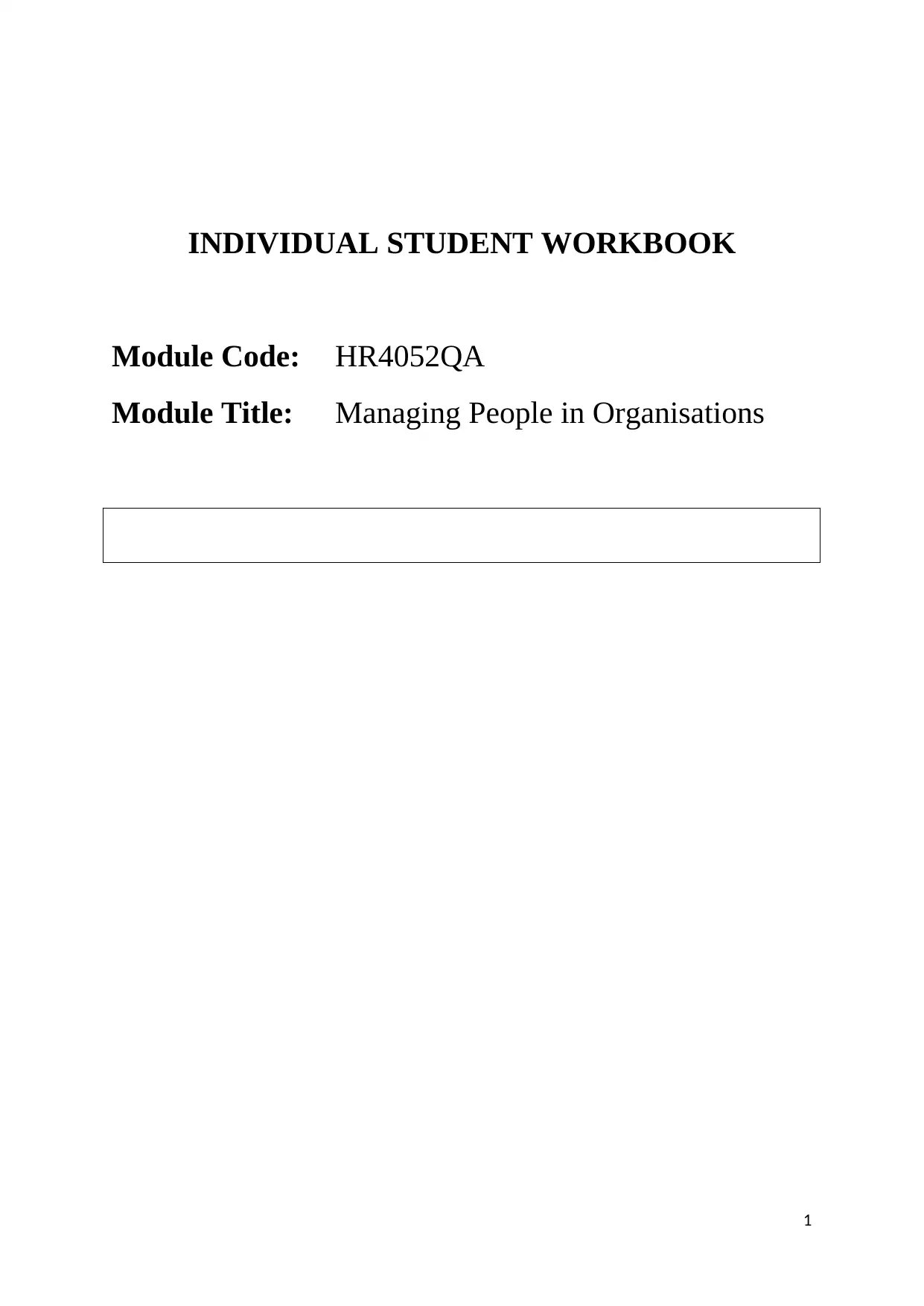
INDIVIDUAL STUDENT WORKBOOK
Module Code: HR4052QA
Module Title: Managing People in Organisations
1
Module Code: HR4052QA
Module Title: Managing People in Organisations
1
Paraphrase This Document
Need a fresh take? Get an instant paraphrase of this document with our AI Paraphraser
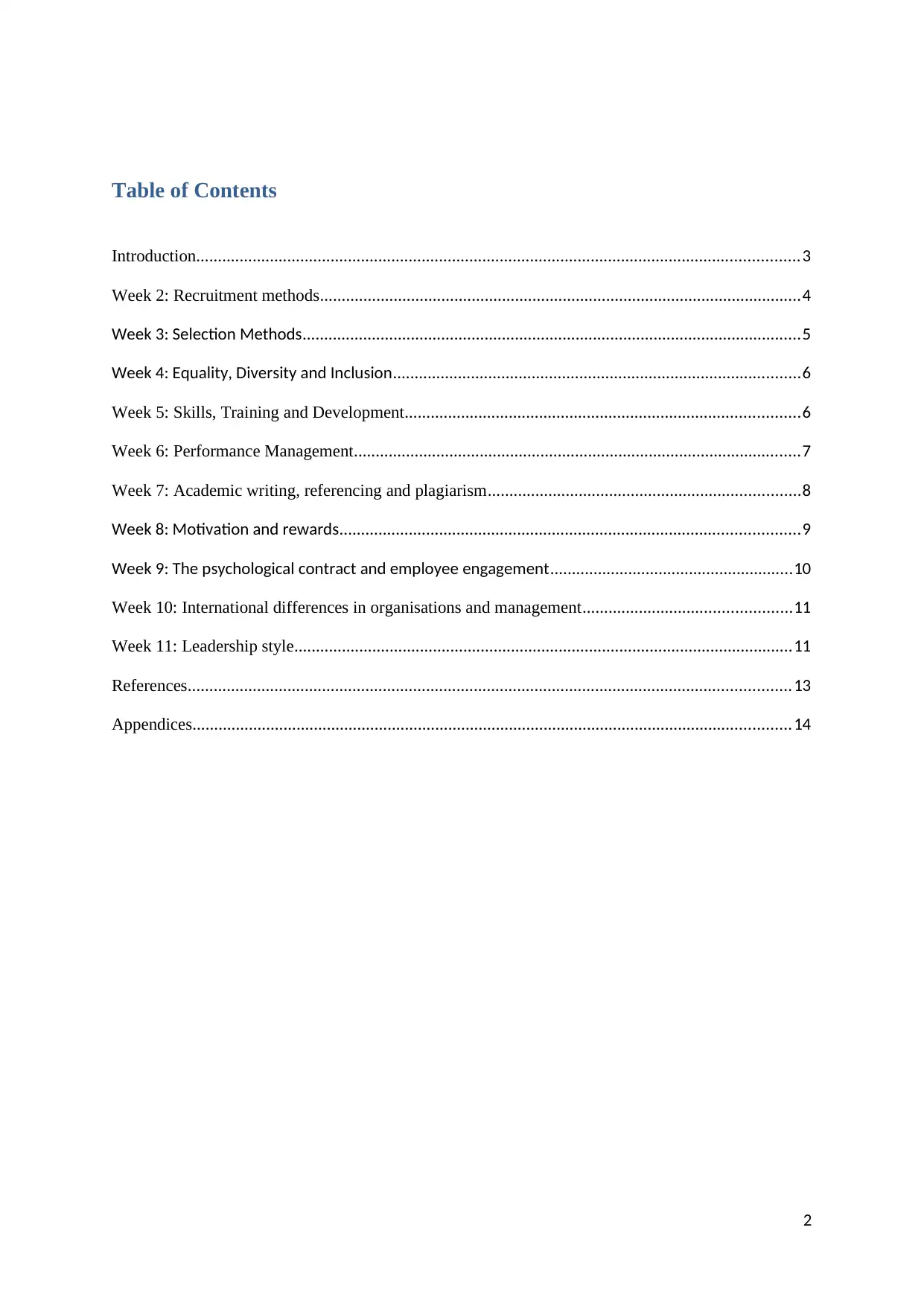
Table of Contents
Introduction...........................................................................................................................................3
Week 2: Recruitment methods...............................................................................................................4
Week 3: Selection Methods...................................................................................................................5
Week 4: Equality, Diversity and Inclusion..............................................................................................6
Week 5: Skills, Training and Development...........................................................................................6
Week 6: Performance Management.......................................................................................................7
Week 7: Academic writing, referencing and plagiarism........................................................................8
Week 8: Motivation and rewards..........................................................................................................9
Week 9: The psychological contract and employee engagement........................................................10
Week 10: International differences in organisations and management................................................11
Week 11: Leadership style...................................................................................................................11
References...........................................................................................................................................13
Appendices..........................................................................................................................................14
2
Introduction...........................................................................................................................................3
Week 2: Recruitment methods...............................................................................................................4
Week 3: Selection Methods...................................................................................................................5
Week 4: Equality, Diversity and Inclusion..............................................................................................6
Week 5: Skills, Training and Development...........................................................................................6
Week 6: Performance Management.......................................................................................................7
Week 7: Academic writing, referencing and plagiarism........................................................................8
Week 8: Motivation and rewards..........................................................................................................9
Week 9: The psychological contract and employee engagement........................................................10
Week 10: International differences in organisations and management................................................11
Week 11: Leadership style...................................................................................................................11
References...........................................................................................................................................13
Appendices..........................................................................................................................................14
2

Introduction
This workbook provides a reflection upon the learning developed from the seminar activities
and class discussions.
The workbook includes ten (weeks 2-11), each includes one or two questions with each
answer in the region of 100-150 words per question.
3
This workbook provides a reflection upon the learning developed from the seminar activities
and class discussions.
The workbook includes ten (weeks 2-11), each includes one or two questions with each
answer in the region of 100-150 words per question.
3
⊘ This is a preview!⊘
Do you want full access?
Subscribe today to unlock all pages.

Trusted by 1+ million students worldwide
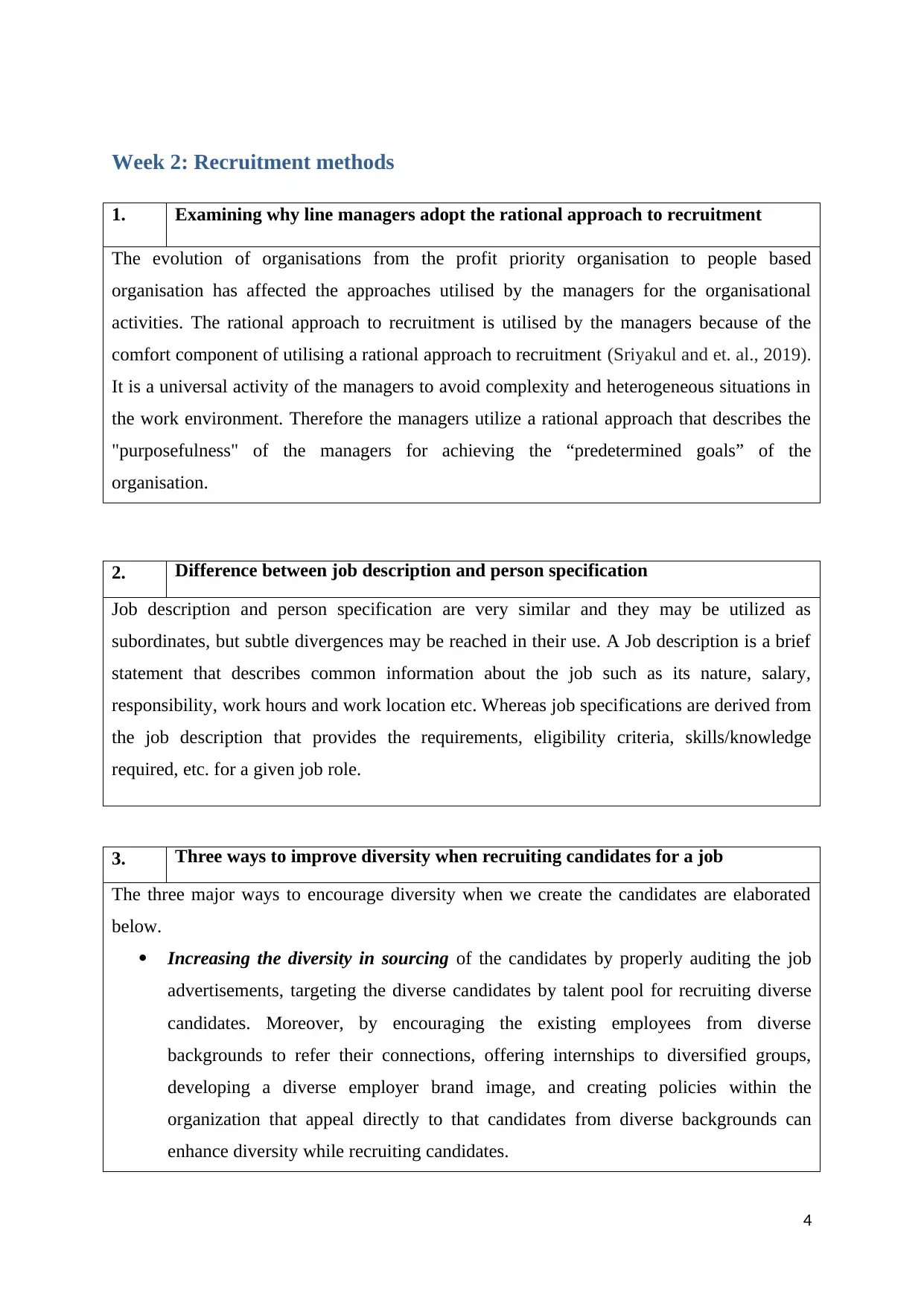
Week 2: Recruitment methods
1. Examining why line managers adopt the rational approach to recruitment
The evolution of organisations from the profit priority organisation to people based
organisation has affected the approaches utilised by the managers for the organisational
activities. The rational approach to recruitment is utilised by the managers because of the
comfort component of utilising a rational approach to recruitment (Sriyakul and et. al., 2019).
It is a universal activity of the managers to avoid complexity and heterogeneous situations in
the work environment. Therefore the managers utilize a rational approach that describes the
"purposefulness" of the managers for achieving the “predetermined goals” of the
organisation.
2. Difference between job description and person specification
Job description and person specification are very similar and they may be utilized as
subordinates, but subtle divergences may be reached in their use. A Job description is a brief
statement that describes common information about the job such as its nature, salary,
responsibility, work hours and work location etc. Whereas job specifications are derived from
the job description that provides the requirements, eligibility criteria, skills/knowledge
required, etc. for a given job role.
3. Three ways to improve diversity when recruiting candidates for a job
The three major ways to encourage diversity when we create the candidates are elaborated
below.
Increasing the diversity in sourcing of the candidates by properly auditing the job
advertisements, targeting the diverse candidates by talent pool for recruiting diverse
candidates. Moreover, by encouraging the existing employees from diverse
backgrounds to refer their connections, offering internships to diversified groups,
developing a diverse employer brand image, and creating policies within the
organization that appeal directly to that candidates from diverse backgrounds can
enhance diversity while recruiting candidates.
4
1. Examining why line managers adopt the rational approach to recruitment
The evolution of organisations from the profit priority organisation to people based
organisation has affected the approaches utilised by the managers for the organisational
activities. The rational approach to recruitment is utilised by the managers because of the
comfort component of utilising a rational approach to recruitment (Sriyakul and et. al., 2019).
It is a universal activity of the managers to avoid complexity and heterogeneous situations in
the work environment. Therefore the managers utilize a rational approach that describes the
"purposefulness" of the managers for achieving the “predetermined goals” of the
organisation.
2. Difference between job description and person specification
Job description and person specification are very similar and they may be utilized as
subordinates, but subtle divergences may be reached in their use. A Job description is a brief
statement that describes common information about the job such as its nature, salary,
responsibility, work hours and work location etc. Whereas job specifications are derived from
the job description that provides the requirements, eligibility criteria, skills/knowledge
required, etc. for a given job role.
3. Three ways to improve diversity when recruiting candidates for a job
The three major ways to encourage diversity when we create the candidates are elaborated
below.
Increasing the diversity in sourcing of the candidates by properly auditing the job
advertisements, targeting the diverse candidates by talent pool for recruiting diverse
candidates. Moreover, by encouraging the existing employees from diverse
backgrounds to refer their connections, offering internships to diversified groups,
developing a diverse employer brand image, and creating policies within the
organization that appeal directly to that candidates from diverse backgrounds can
enhance diversity while recruiting candidates.
4
Paraphrase This Document
Need a fresh take? Get an instant paraphrase of this document with our AI Paraphraser
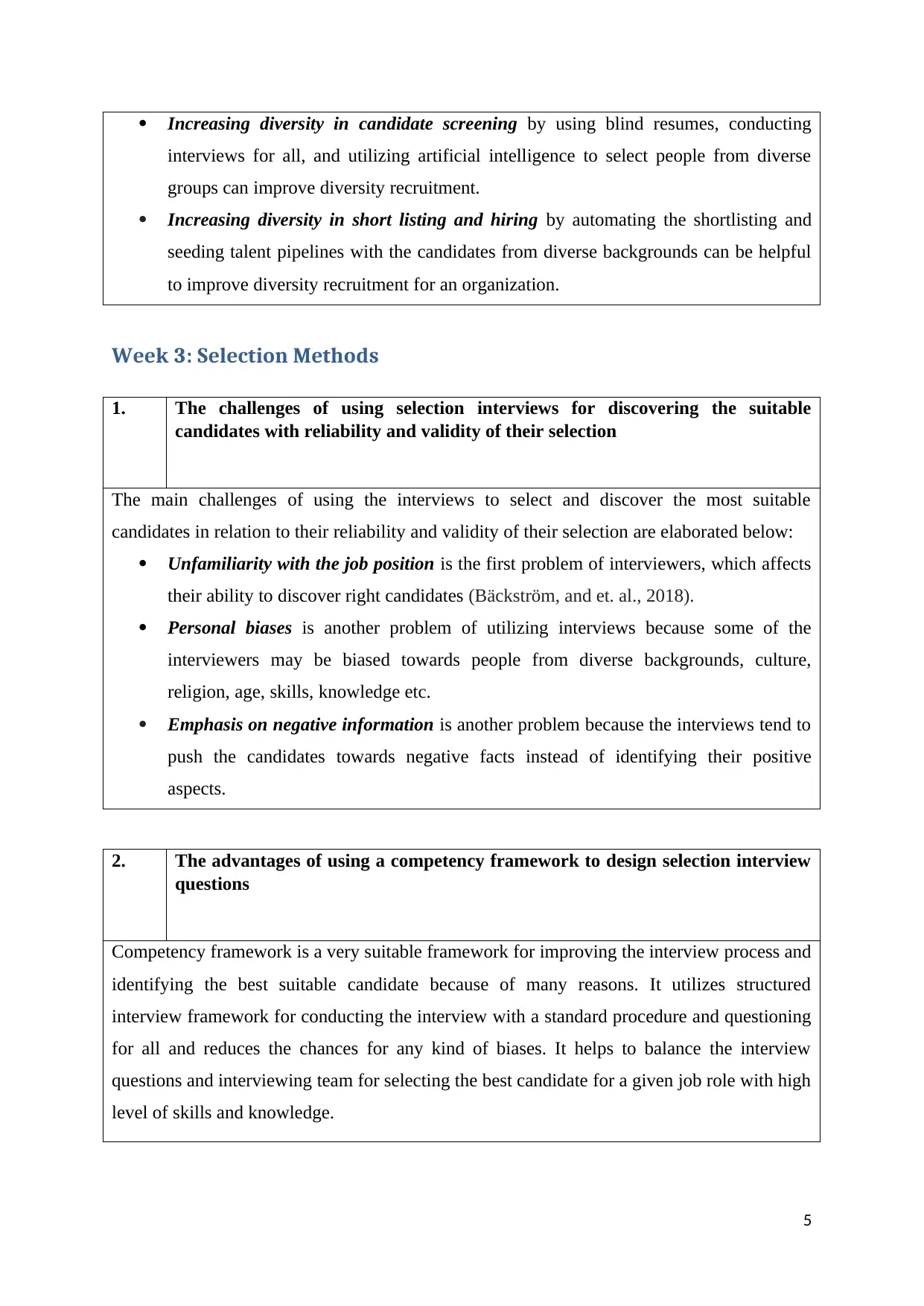
Increasing diversity in candidate screening by using blind resumes, conducting
interviews for all, and utilizing artificial intelligence to select people from diverse
groups can improve diversity recruitment.
Increasing diversity in short listing and hiring by automating the shortlisting and
seeding talent pipelines with the candidates from diverse backgrounds can be helpful
to improve diversity recruitment for an organization.
Week 3: Selection Methods
1. The challenges of using selection interviews for discovering the suitable
candidates with reliability and validity of their selection
The main challenges of using the interviews to select and discover the most suitable
candidates in relation to their reliability and validity of their selection are elaborated below:
Unfamiliarity with the job position is the first problem of interviewers, which affects
their ability to discover right candidates (Bäckström, and et. al., 2018).
Personal biases is another problem of utilizing interviews because some of the
interviewers may be biased towards people from diverse backgrounds, culture,
religion, age, skills, knowledge etc.
Emphasis on negative information is another problem because the interviews tend to
push the candidates towards negative facts instead of identifying their positive
aspects.
2. The advantages of using a competency framework to design selection interview
questions
Competency framework is a very suitable framework for improving the interview process and
identifying the best suitable candidate because of many reasons. It utilizes structured
interview framework for conducting the interview with a standard procedure and questioning
for all and reduces the chances for any kind of biases. It helps to balance the interview
questions and interviewing team for selecting the best candidate for a given job role with high
level of skills and knowledge.
5
interviews for all, and utilizing artificial intelligence to select people from diverse
groups can improve diversity recruitment.
Increasing diversity in short listing and hiring by automating the shortlisting and
seeding talent pipelines with the candidates from diverse backgrounds can be helpful
to improve diversity recruitment for an organization.
Week 3: Selection Methods
1. The challenges of using selection interviews for discovering the suitable
candidates with reliability and validity of their selection
The main challenges of using the interviews to select and discover the most suitable
candidates in relation to their reliability and validity of their selection are elaborated below:
Unfamiliarity with the job position is the first problem of interviewers, which affects
their ability to discover right candidates (Bäckström, and et. al., 2018).
Personal biases is another problem of utilizing interviews because some of the
interviewers may be biased towards people from diverse backgrounds, culture,
religion, age, skills, knowledge etc.
Emphasis on negative information is another problem because the interviews tend to
push the candidates towards negative facts instead of identifying their positive
aspects.
2. The advantages of using a competency framework to design selection interview
questions
Competency framework is a very suitable framework for improving the interview process and
identifying the best suitable candidate because of many reasons. It utilizes structured
interview framework for conducting the interview with a standard procedure and questioning
for all and reduces the chances for any kind of biases. It helps to balance the interview
questions and interviewing team for selecting the best candidate for a given job role with high
level of skills and knowledge.
5
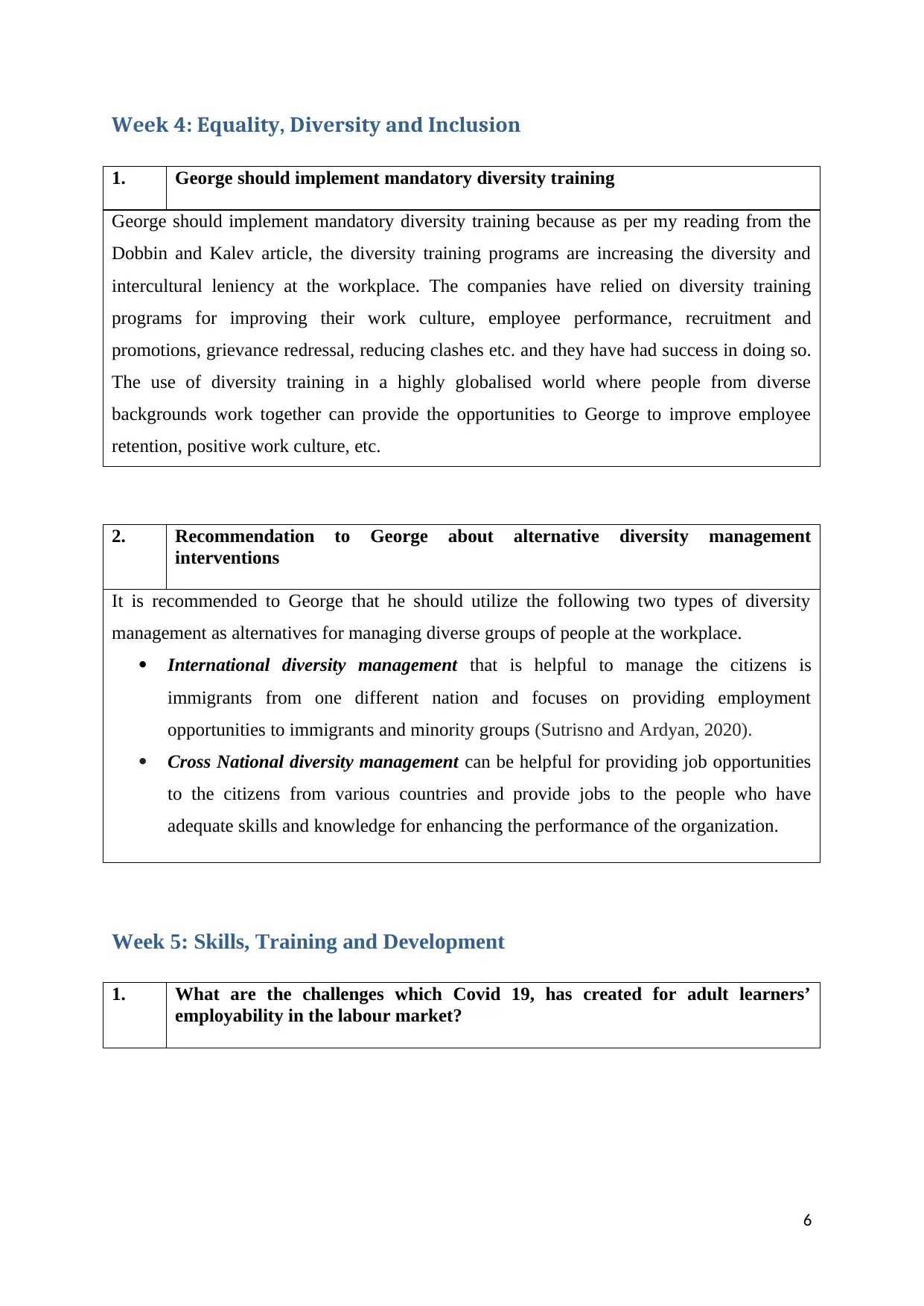
Week 4: Equality, Diversity and Inclusion
1. George should implement mandatory diversity training
George should implement mandatory diversity training because as per my reading from the
Dobbin and Kalev article, the diversity training programs are increasing the diversity and
intercultural leniency at the workplace. The companies have relied on diversity training
programs for improving their work culture, employee performance, recruitment and
promotions, grievance redressal, reducing clashes etc. and they have had success in doing so.
The use of diversity training in a highly globalised world where people from diverse
backgrounds work together can provide the opportunities to George to improve employee
retention, positive work culture, etc.
2. Recommendation to George about alternative diversity management
interventions
It is recommended to George that he should utilize the following two types of diversity
management as alternatives for managing diverse groups of people at the workplace.
International diversity management that is helpful to manage the citizens is
immigrants from one different nation and focuses on providing employment
opportunities to immigrants and minority groups (Sutrisno and Ardyan, 2020).
Cross National diversity management can be helpful for providing job opportunities
to the citizens from various countries and provide jobs to the people who have
adequate skills and knowledge for enhancing the performance of the organization.
Week 5: Skills, Training and Development
1. What are the challenges which Covid 19, has created for adult learners’
employability in the labour market?
6
1. George should implement mandatory diversity training
George should implement mandatory diversity training because as per my reading from the
Dobbin and Kalev article, the diversity training programs are increasing the diversity and
intercultural leniency at the workplace. The companies have relied on diversity training
programs for improving their work culture, employee performance, recruitment and
promotions, grievance redressal, reducing clashes etc. and they have had success in doing so.
The use of diversity training in a highly globalised world where people from diverse
backgrounds work together can provide the opportunities to George to improve employee
retention, positive work culture, etc.
2. Recommendation to George about alternative diversity management
interventions
It is recommended to George that he should utilize the following two types of diversity
management as alternatives for managing diverse groups of people at the workplace.
International diversity management that is helpful to manage the citizens is
immigrants from one different nation and focuses on providing employment
opportunities to immigrants and minority groups (Sutrisno and Ardyan, 2020).
Cross National diversity management can be helpful for providing job opportunities
to the citizens from various countries and provide jobs to the people who have
adequate skills and knowledge for enhancing the performance of the organization.
Week 5: Skills, Training and Development
1. What are the challenges which Covid 19, has created for adult learners’
employability in the labour market?
6
⊘ This is a preview!⊘
Do you want full access?
Subscribe today to unlock all pages.

Trusted by 1+ million students worldwide
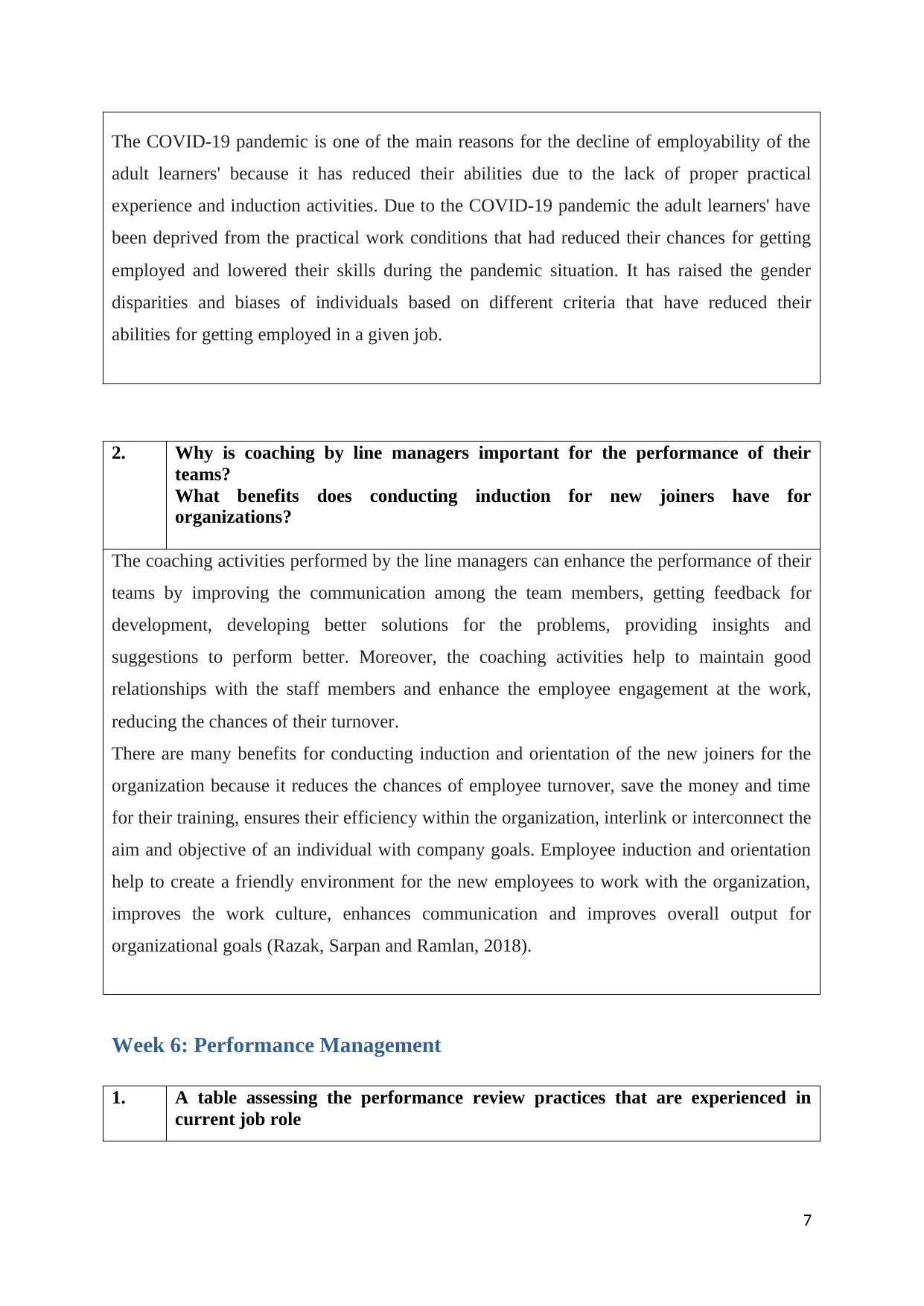
The COVID-19 pandemic is one of the main reasons for the decline of employability of the
adult learners' because it has reduced their abilities due to the lack of proper practical
experience and induction activities. Due to the COVID-19 pandemic the adult learners' have
been deprived from the practical work conditions that had reduced their chances for getting
employed and lowered their skills during the pandemic situation. It has raised the gender
disparities and biases of individuals based on different criteria that have reduced their
abilities for getting employed in a given job.
2. Why is coaching by line managers important for the performance of their
teams?
What benefits does conducting induction for new joiners have for
organizations?
The coaching activities performed by the line managers can enhance the performance of their
teams by improving the communication among the team members, getting feedback for
development, developing better solutions for the problems, providing insights and
suggestions to perform better. Moreover, the coaching activities help to maintain good
relationships with the staff members and enhance the employee engagement at the work,
reducing the chances of their turnover.
There are many benefits for conducting induction and orientation of the new joiners for the
organization because it reduces the chances of employee turnover, save the money and time
for their training, ensures their efficiency within the organization, interlink or interconnect the
aim and objective of an individual with company goals. Employee induction and orientation
help to create a friendly environment for the new employees to work with the organization,
improves the work culture, enhances communication and improves overall output for
organizational goals (Razak, Sarpan and Ramlan, 2018).
Week 6: Performance Management
1. A table assessing the performance review practices that are experienced in
current job role
7
adult learners' because it has reduced their abilities due to the lack of proper practical
experience and induction activities. Due to the COVID-19 pandemic the adult learners' have
been deprived from the practical work conditions that had reduced their chances for getting
employed and lowered their skills during the pandemic situation. It has raised the gender
disparities and biases of individuals based on different criteria that have reduced their
abilities for getting employed in a given job.
2. Why is coaching by line managers important for the performance of their
teams?
What benefits does conducting induction for new joiners have for
organizations?
The coaching activities performed by the line managers can enhance the performance of their
teams by improving the communication among the team members, getting feedback for
development, developing better solutions for the problems, providing insights and
suggestions to perform better. Moreover, the coaching activities help to maintain good
relationships with the staff members and enhance the employee engagement at the work,
reducing the chances of their turnover.
There are many benefits for conducting induction and orientation of the new joiners for the
organization because it reduces the chances of employee turnover, save the money and time
for their training, ensures their efficiency within the organization, interlink or interconnect the
aim and objective of an individual with company goals. Employee induction and orientation
help to create a friendly environment for the new employees to work with the organization,
improves the work culture, enhances communication and improves overall output for
organizational goals (Razak, Sarpan and Ramlan, 2018).
Week 6: Performance Management
1. A table assessing the performance review practices that are experienced in
current job role
7
Paraphrase This Document
Need a fresh take? Get an instant paraphrase of this document with our AI Paraphraser
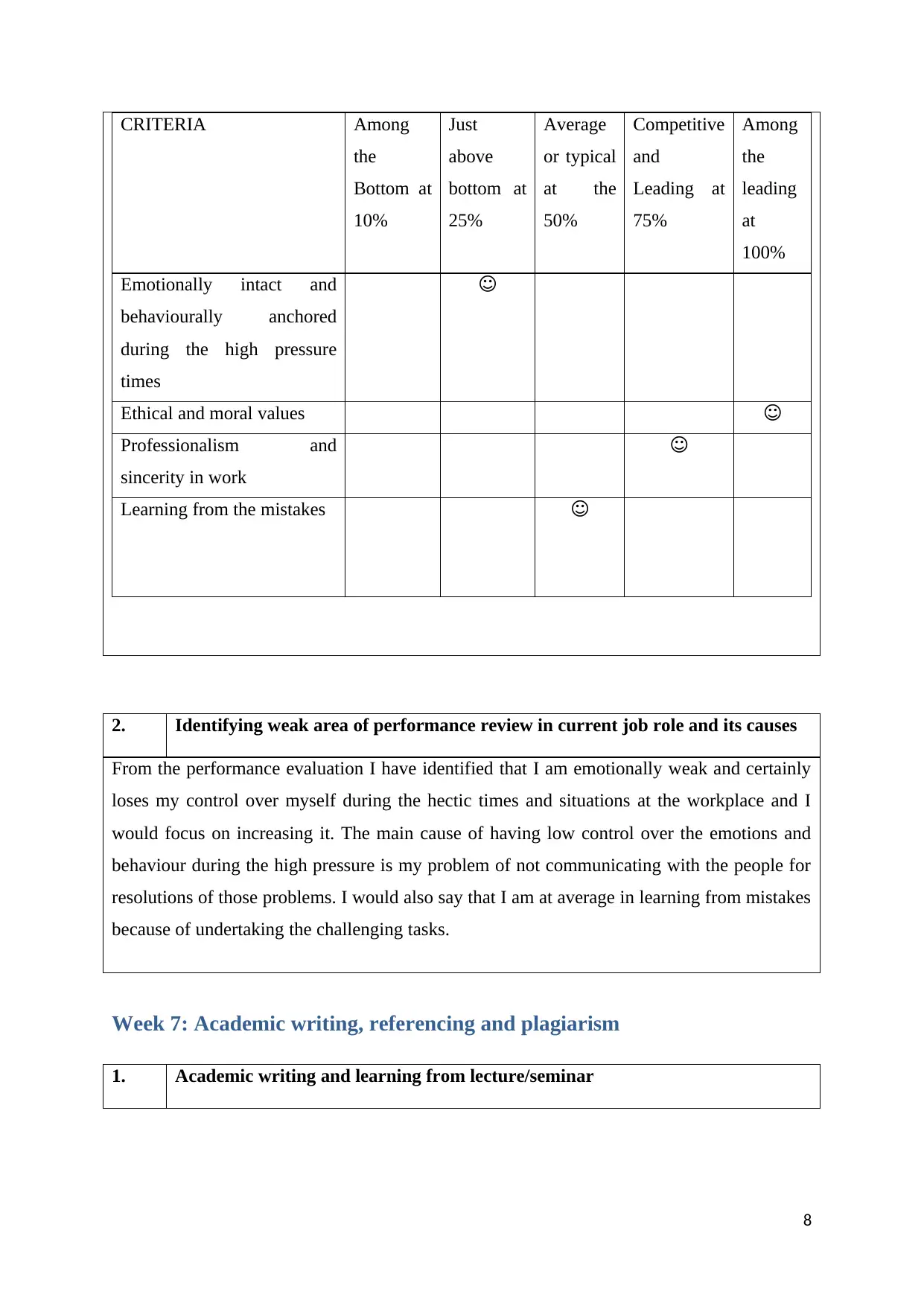
CRITERIA Among
the
Bottom at
10%
Just
above
bottom at
25%
Average
or typical
at the
50%
Competitive
and
Leading at
75%
Among
the
leading
at
100%
Emotionally intact and
behaviourally anchored
during the high pressure
times
☺
Ethical and moral values ☺
Professionalism and
sincerity in work
☺
Learning from the mistakes ☺
2. Identifying weak area of performance review in current job role and its causes
From the performance evaluation I have identified that I am emotionally weak and certainly
loses my control over myself during the hectic times and situations at the workplace and I
would focus on increasing it. The main cause of having low control over the emotions and
behaviour during the high pressure is my problem of not communicating with the people for
resolutions of those problems. I would also say that I am at average in learning from mistakes
because of undertaking the challenging tasks.
Week 7: Academic writing, referencing and plagiarism
1. Academic writing and learning from lecture/seminar
8
the
Bottom at
10%
Just
above
bottom at
25%
Average
or typical
at the
50%
Competitive
and
Leading at
75%
Among
the
leading
at
100%
Emotionally intact and
behaviourally anchored
during the high pressure
times
☺
Ethical and moral values ☺
Professionalism and
sincerity in work
☺
Learning from the mistakes ☺
2. Identifying weak area of performance review in current job role and its causes
From the performance evaluation I have identified that I am emotionally weak and certainly
loses my control over myself during the hectic times and situations at the workplace and I
would focus on increasing it. The main cause of having low control over the emotions and
behaviour during the high pressure is my problem of not communicating with the people for
resolutions of those problems. I would also say that I am at average in learning from mistakes
because of undertaking the challenging tasks.
Week 7: Academic writing, referencing and plagiarism
1. Academic writing and learning from lecture/seminar
8
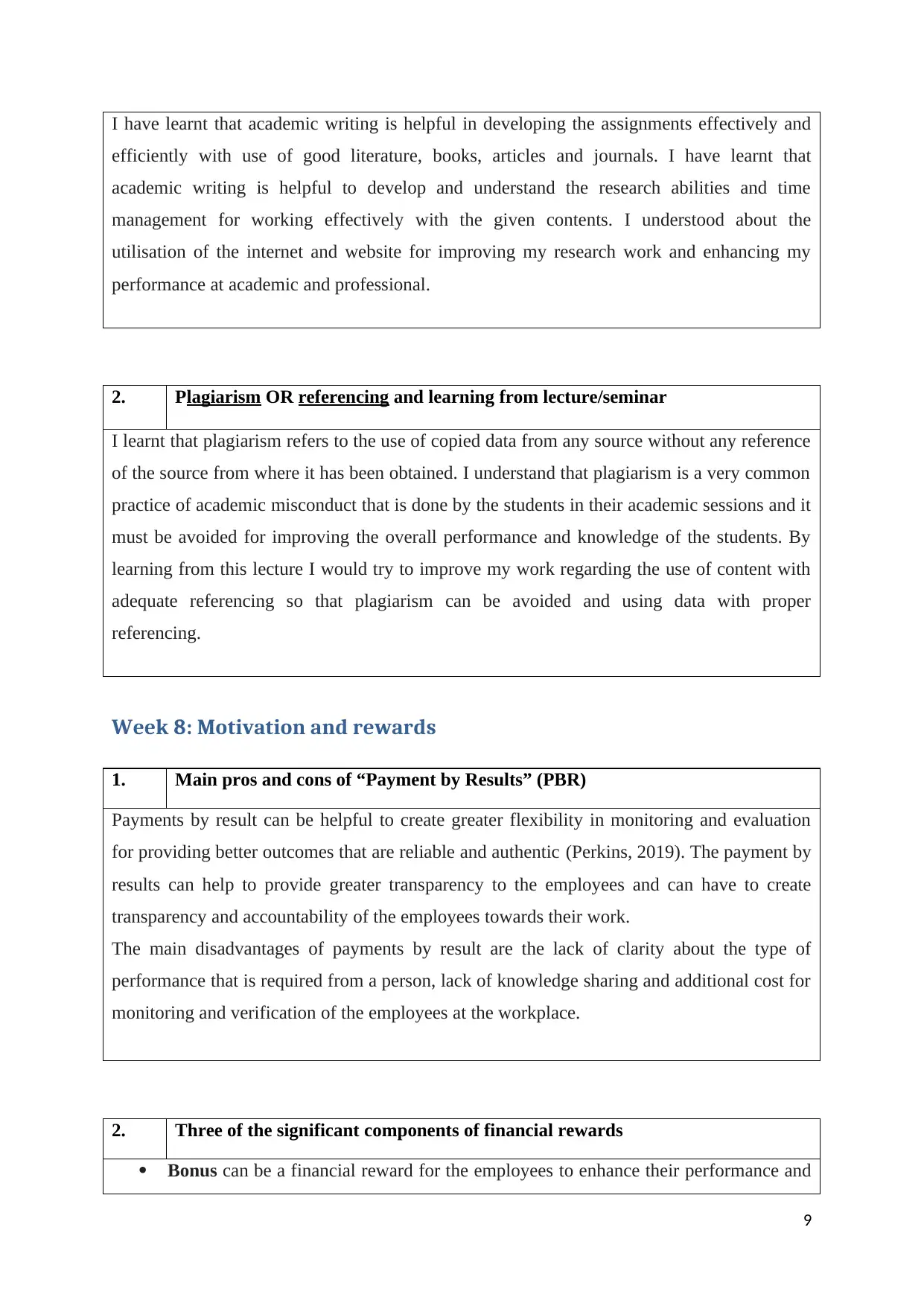
I have learnt that academic writing is helpful in developing the assignments effectively and
efficiently with use of good literature, books, articles and journals. I have learnt that
academic writing is helpful to develop and understand the research abilities and time
management for working effectively with the given contents. I understood about the
utilisation of the internet and website for improving my research work and enhancing my
performance at academic and professional.
2. Plagiarism OR referencing and learning from lecture/seminar
I learnt that plagiarism refers to the use of copied data from any source without any reference
of the source from where it has been obtained. I understand that plagiarism is a very common
practice of academic misconduct that is done by the students in their academic sessions and it
must be avoided for improving the overall performance and knowledge of the students. By
learning from this lecture I would try to improve my work regarding the use of content with
adequate referencing so that plagiarism can be avoided and using data with proper
referencing.
Week 8: Motivation and rewards
1. Main pros and cons of “Payment by Results” (PBR)
Payments by result can be helpful to create greater flexibility in monitoring and evaluation
for providing better outcomes that are reliable and authentic (Perkins, 2019). The payment by
results can help to provide greater transparency to the employees and can have to create
transparency and accountability of the employees towards their work.
The main disadvantages of payments by result are the lack of clarity about the type of
performance that is required from a person, lack of knowledge sharing and additional cost for
monitoring and verification of the employees at the workplace.
2. Three of the significant components of financial rewards
Bonus can be a financial reward for the employees to enhance their performance and
9
efficiently with use of good literature, books, articles and journals. I have learnt that
academic writing is helpful to develop and understand the research abilities and time
management for working effectively with the given contents. I understood about the
utilisation of the internet and website for improving my research work and enhancing my
performance at academic and professional.
2. Plagiarism OR referencing and learning from lecture/seminar
I learnt that plagiarism refers to the use of copied data from any source without any reference
of the source from where it has been obtained. I understand that plagiarism is a very common
practice of academic misconduct that is done by the students in their academic sessions and it
must be avoided for improving the overall performance and knowledge of the students. By
learning from this lecture I would try to improve my work regarding the use of content with
adequate referencing so that plagiarism can be avoided and using data with proper
referencing.
Week 8: Motivation and rewards
1. Main pros and cons of “Payment by Results” (PBR)
Payments by result can be helpful to create greater flexibility in monitoring and evaluation
for providing better outcomes that are reliable and authentic (Perkins, 2019). The payment by
results can help to provide greater transparency to the employees and can have to create
transparency and accountability of the employees towards their work.
The main disadvantages of payments by result are the lack of clarity about the type of
performance that is required from a person, lack of knowledge sharing and additional cost for
monitoring and verification of the employees at the workplace.
2. Three of the significant components of financial rewards
Bonus can be a financial reward for the employees to enhance their performance and
9
⊘ This is a preview!⊘
Do you want full access?
Subscribe today to unlock all pages.

Trusted by 1+ million students worldwide
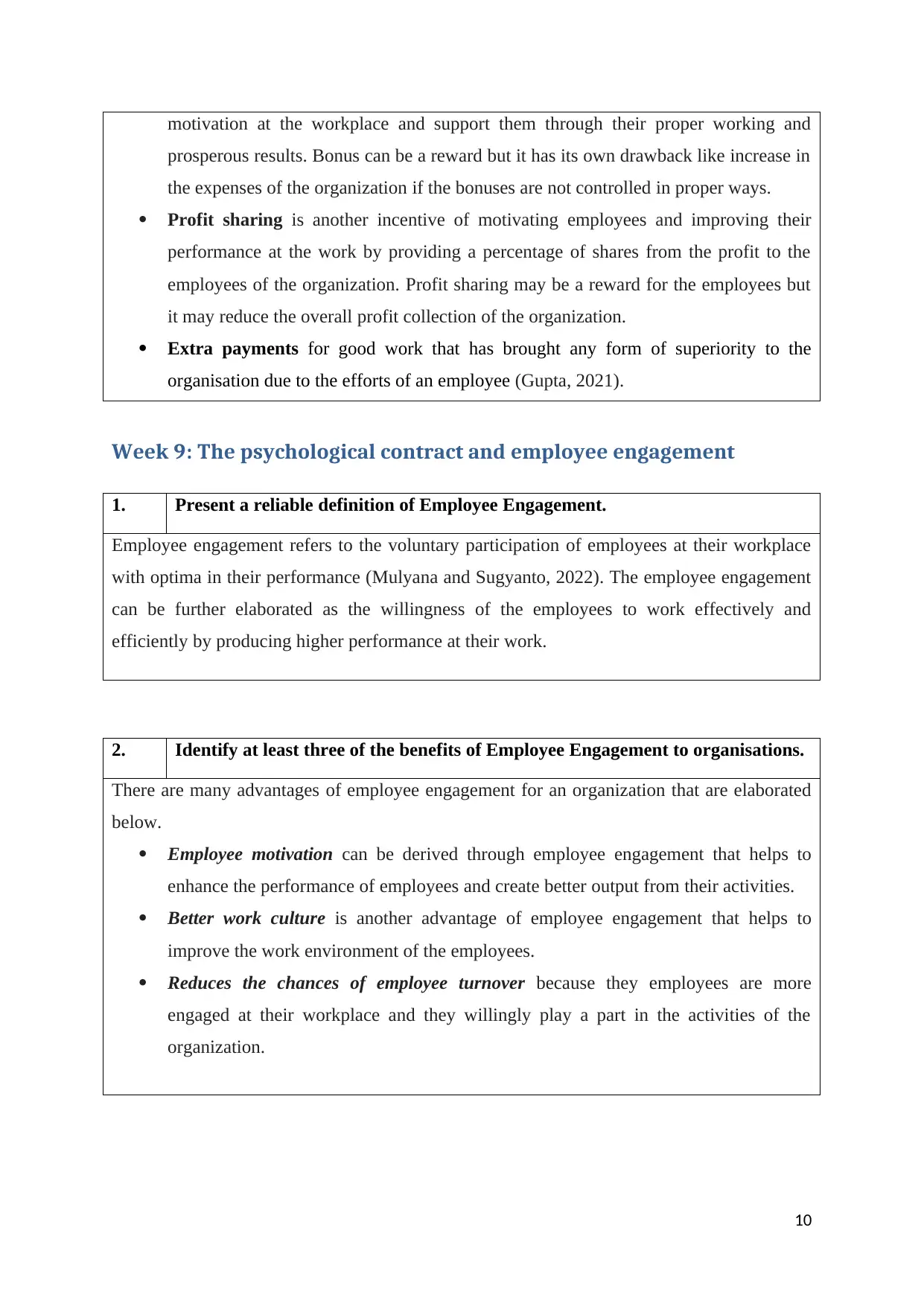
motivation at the workplace and support them through their proper working and
prosperous results. Bonus can be a reward but it has its own drawback like increase in
the expenses of the organization if the bonuses are not controlled in proper ways.
Profit sharing is another incentive of motivating employees and improving their
performance at the work by providing a percentage of shares from the profit to the
employees of the organization. Profit sharing may be a reward for the employees but
it may reduce the overall profit collection of the organization.
Extra payments for good work that has brought any form of superiority to the
organisation due to the efforts of an employee (Gupta, 2021).
Week 9: The psychological contract and employee engagement
1. Present a reliable definition of Employee Engagement.
Employee engagement refers to the voluntary participation of employees at their workplace
with optima in their performance (Mulyana and Sugyanto, 2022). The employee engagement
can be further elaborated as the willingness of the employees to work effectively and
efficiently by producing higher performance at their work.
2. Identify at least three of the benefits of Employee Engagement to organisations.
There are many advantages of employee engagement for an organization that are elaborated
below.
Employee motivation can be derived through employee engagement that helps to
enhance the performance of employees and create better output from their activities.
Better work culture is another advantage of employee engagement that helps to
improve the work environment of the employees.
Reduces the chances of employee turnover because they employees are more
engaged at their workplace and they willingly play a part in the activities of the
organization.
10
prosperous results. Bonus can be a reward but it has its own drawback like increase in
the expenses of the organization if the bonuses are not controlled in proper ways.
Profit sharing is another incentive of motivating employees and improving their
performance at the work by providing a percentage of shares from the profit to the
employees of the organization. Profit sharing may be a reward for the employees but
it may reduce the overall profit collection of the organization.
Extra payments for good work that has brought any form of superiority to the
organisation due to the efforts of an employee (Gupta, 2021).
Week 9: The psychological contract and employee engagement
1. Present a reliable definition of Employee Engagement.
Employee engagement refers to the voluntary participation of employees at their workplace
with optima in their performance (Mulyana and Sugyanto, 2022). The employee engagement
can be further elaborated as the willingness of the employees to work effectively and
efficiently by producing higher performance at their work.
2. Identify at least three of the benefits of Employee Engagement to organisations.
There are many advantages of employee engagement for an organization that are elaborated
below.
Employee motivation can be derived through employee engagement that helps to
enhance the performance of employees and create better output from their activities.
Better work culture is another advantage of employee engagement that helps to
improve the work environment of the employees.
Reduces the chances of employee turnover because they employees are more
engaged at their workplace and they willingly play a part in the activities of the
organization.
10
Paraphrase This Document
Need a fresh take? Get an instant paraphrase of this document with our AI Paraphraser
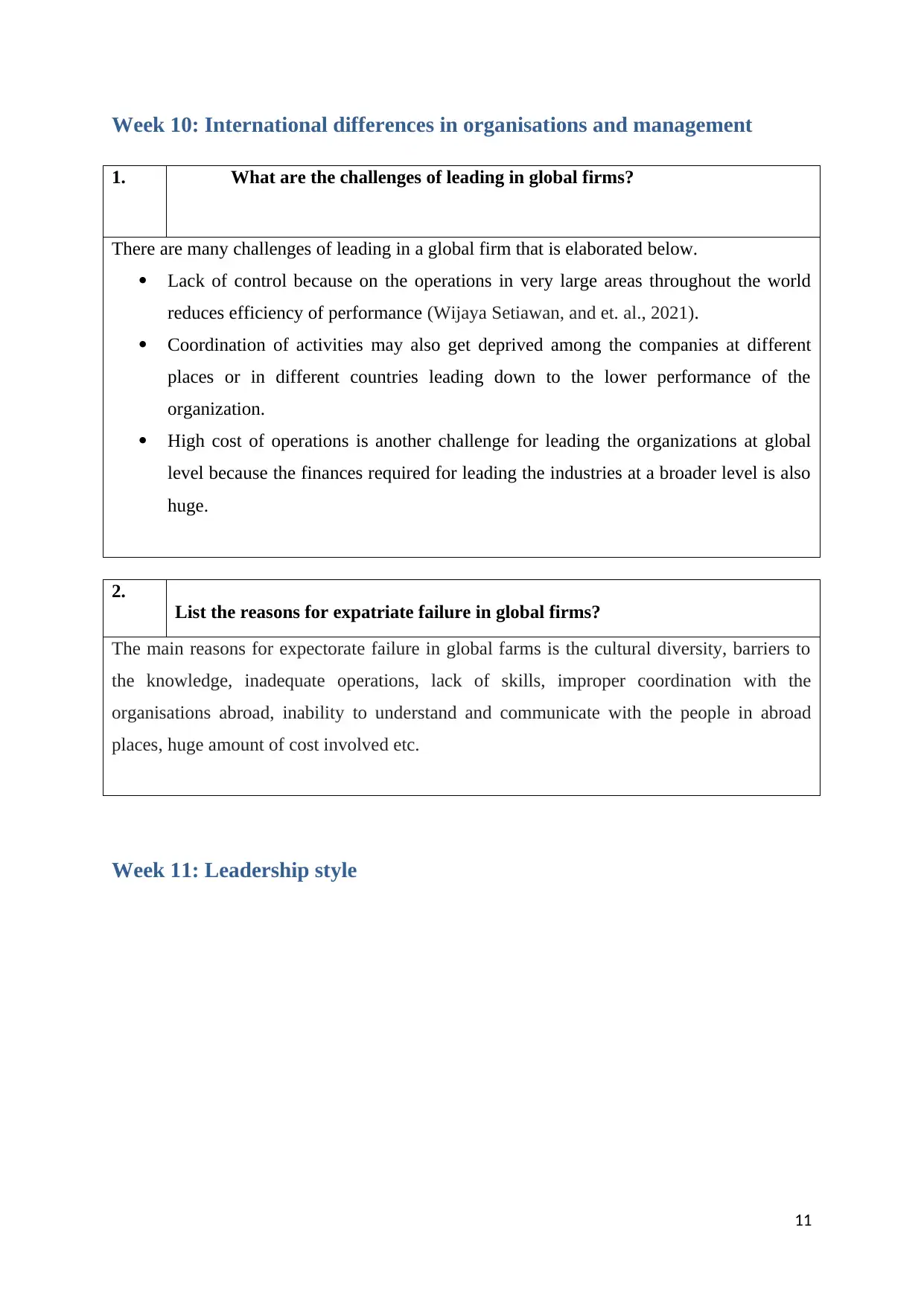
Week 10: International differences in organisations and management
1. What are the challenges of leading in global firms?
There are many challenges of leading in a global firm that is elaborated below.
Lack of control because on the operations in very large areas throughout the world
reduces efficiency of performance (Wijaya Setiawan, and et. al., 2021).
Coordination of activities may also get deprived among the companies at different
places or in different countries leading down to the lower performance of the
organization.
High cost of operations is another challenge for leading the organizations at global
level because the finances required for leading the industries at a broader level is also
huge.
2.
List the reasons for expatriate failure in global firms?
The main reasons for expectorate failure in global farms is the cultural diversity, barriers to
the knowledge, inadequate operations, lack of skills, improper coordination with the
organisations abroad, inability to understand and communicate with the people in abroad
places, huge amount of cost involved etc.
Week 11: Leadership style
11
1. What are the challenges of leading in global firms?
There are many challenges of leading in a global firm that is elaborated below.
Lack of control because on the operations in very large areas throughout the world
reduces efficiency of performance (Wijaya Setiawan, and et. al., 2021).
Coordination of activities may also get deprived among the companies at different
places or in different countries leading down to the lower performance of the
organization.
High cost of operations is another challenge for leading the organizations at global
level because the finances required for leading the industries at a broader level is also
huge.
2.
List the reasons for expatriate failure in global firms?
The main reasons for expectorate failure in global farms is the cultural diversity, barriers to
the knowledge, inadequate operations, lack of skills, improper coordination with the
organisations abroad, inability to understand and communicate with the people in abroad
places, huge amount of cost involved etc.
Week 11: Leadership style
11
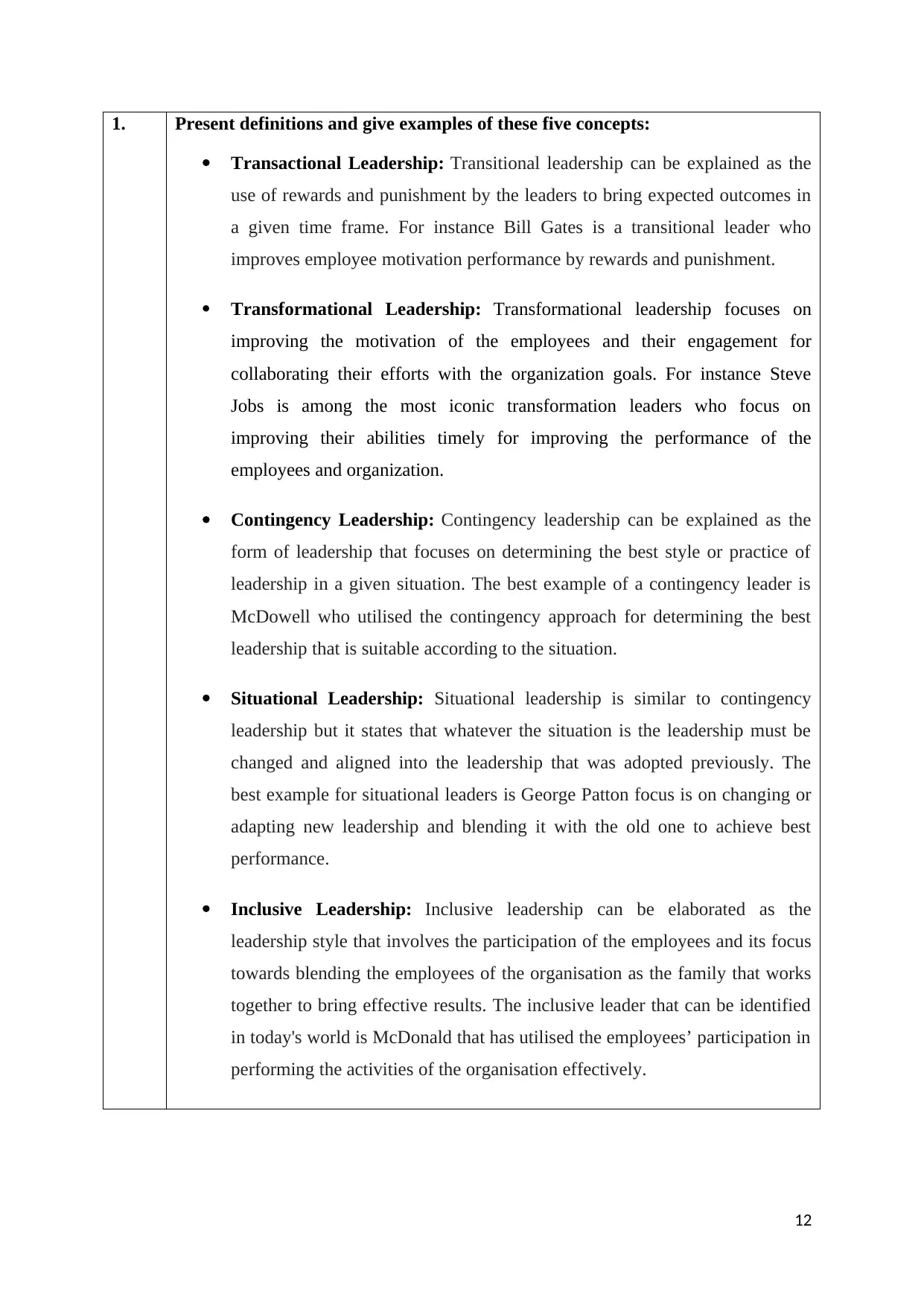
1. Present definitions and give examples of these five concepts:
Transactional Leadership: Transitional leadership can be explained as the
use of rewards and punishment by the leaders to bring expected outcomes in
a given time frame. For instance Bill Gates is a transitional leader who
improves employee motivation performance by rewards and punishment.
Transformational Leadership: Transformational leadership focuses on
improving the motivation of the employees and their engagement for
collaborating their efforts with the organization goals. For instance Steve
Jobs is among the most iconic transformation leaders who focus on
improving their abilities timely for improving the performance of the
employees and organization.
Contingency Leadership: Contingency leadership can be explained as the
form of leadership that focuses on determining the best style or practice of
leadership in a given situation. The best example of a contingency leader is
McDowell who utilised the contingency approach for determining the best
leadership that is suitable according to the situation.
Situational Leadership: Situational leadership is similar to contingency
leadership but it states that whatever the situation is the leadership must be
changed and aligned into the leadership that was adopted previously. The
best example for situational leaders is George Patton focus is on changing or
adapting new leadership and blending it with the old one to achieve best
performance.
Inclusive Leadership: Inclusive leadership can be elaborated as the
leadership style that involves the participation of the employees and its focus
towards blending the employees of the organisation as the family that works
together to bring effective results. The inclusive leader that can be identified
in today's world is McDonald that has utilised the employees’ participation in
performing the activities of the organisation effectively.
12
Transactional Leadership: Transitional leadership can be explained as the
use of rewards and punishment by the leaders to bring expected outcomes in
a given time frame. For instance Bill Gates is a transitional leader who
improves employee motivation performance by rewards and punishment.
Transformational Leadership: Transformational leadership focuses on
improving the motivation of the employees and their engagement for
collaborating their efforts with the organization goals. For instance Steve
Jobs is among the most iconic transformation leaders who focus on
improving their abilities timely for improving the performance of the
employees and organization.
Contingency Leadership: Contingency leadership can be explained as the
form of leadership that focuses on determining the best style or practice of
leadership in a given situation. The best example of a contingency leader is
McDowell who utilised the contingency approach for determining the best
leadership that is suitable according to the situation.
Situational Leadership: Situational leadership is similar to contingency
leadership but it states that whatever the situation is the leadership must be
changed and aligned into the leadership that was adopted previously. The
best example for situational leaders is George Patton focus is on changing or
adapting new leadership and blending it with the old one to achieve best
performance.
Inclusive Leadership: Inclusive leadership can be elaborated as the
leadership style that involves the participation of the employees and its focus
towards blending the employees of the organisation as the family that works
together to bring effective results. The inclusive leader that can be identified
in today's world is McDonald that has utilised the employees’ participation in
performing the activities of the organisation effectively.
12
⊘ This is a preview!⊘
Do you want full access?
Subscribe today to unlock all pages.

Trusted by 1+ million students worldwide
1 out of 14
Related Documents
Your All-in-One AI-Powered Toolkit for Academic Success.
+13062052269
info@desklib.com
Available 24*7 on WhatsApp / Email
![[object Object]](/_next/static/media/star-bottom.7253800d.svg)
Unlock your academic potential
Copyright © 2020–2025 A2Z Services. All Rights Reserved. Developed and managed by ZUCOL.



